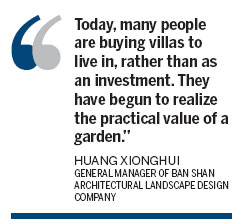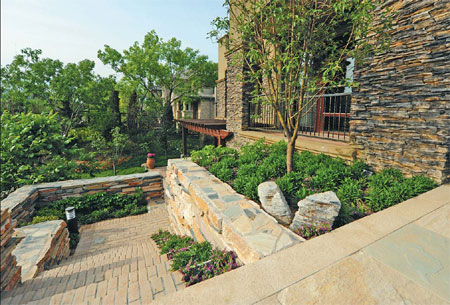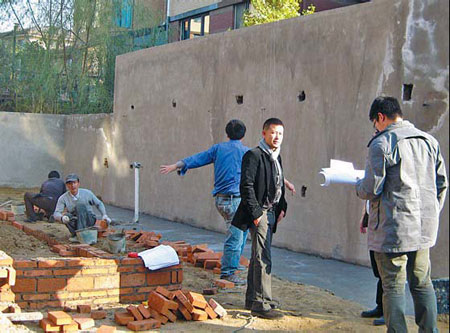Society
Garden of delights
Updated: 2011-08-09 08:39
By Wang Kaihao (China Daily)
|
A garden designed by Ban Shan Architectural Landscape Design Company in Beijing. Photos Provided to China Daily |
|
Huang Xionghui (second from right) works on a landscaping project for a Beijing villa. |
 |
Chinese owners of villas are now forking out big bucks for their landscaping. Wang Kaihao reports.
While living in a villa with spacious rooms and fancy decor far from the hustle and bustle of downtown areas is a dream come true for many well-heeled Chinese, they are becoming aware of their spacious outdoors areas too. And they are increasingly willing to spend on sprucing up this garden space, for those special moments, like a quiet morning read in the shade of a tree, or a noisy evening barbecue with friends beside a grape trellis.
He Qinglan, who works at a public relations firm, bought her first house with a 200-square-meter garden in a new villa neighborhood just off the Jingcheng Expressway in Beijing's Shunyi district in 2008.
"What makes a villa different from an apartment is its outdoor space," He says. "I want to make full use of my garden as a place for relaxation and entertainment."
He spent 200,000 yuan ($31,000) to decorate her garden, roughly the same amount that she spent on doing up the villa itself.
"Functionality is the first thing a house owner should consider," Yang Yi, chief designer of the Beijing-based Ban Shan Architectural Landscape Design Company, says.
"A garden should be so designed that it allows for outdoor activities such as parties and large family gatherings."
However, just five years ago, few villa owners in China paid any attention to their gardens, Huang Xionghui, general manager of Ban Shan company, says.
"Today, many people are buying villas to live in, rather than as an investment," Huang says. "They have begun to realize the practical value of a garden."
Huang says the Tuscan style garden, first introduced to Beijing about three years ago, accounts for nearly 80 percent of garden designs for new villas around the capital.
He Qinglan, from the PR firm, has also gone for this style, which tries to replicate the typical Mediterranean look in central Italy's Tuscany.
"The style feels natural," He says. "And really conveys the warmth of home."
The defining features of such a garden are paths paved with brightly colored pisolites and red clay bricks, evergreen arbors and bushes, flowering ground cover, flowerpots and terrines placed on windowsills and balconies, wall fountains, and brick and stone decorations with a rustic touch.
Huang says there are still villa owners who prefer Chinese or classic European styles, that employ expensive building materials for a wooden pavilion or a fountain and marble pillars.
Sha Ling, a civil servant, bought an apartment along Beijing's East Second Ring Road in 2010 that comes with a 100-square-meter roof garden.
"I wanted this space to be both aesthetic and practical," Sha says. "I also needed some water features and plants to awaken my senses when I walk in."
So she has put in a fishpond and a small greenhouse in her Japanese-style outdoor space whose grounds are paved with stones.
Though the Tuscan style dominates landscape design today, Yang, who has lived in Germany for years, believes it will soon give way to the modernist look, which is simpler and more functional and popular with young people in the West.
"The villa buyers of tomorrow are bound to go for practicality and convenience. We designers have to think in advance."
Huang adds that it is also easier for young people to accept the idea of paying for garden design. Although older villa owners don't begrudge spending on luxury building materials, they are often not too keen to spend on a garden."
Huang's company charges 200 yuan ($30) per square meter for designing a space that is less than 500 square meters, but it goes lower for a bigger space. It usually takes his team half a month to conceptualize the design and two more months to transfer it into reality.
Unlike interior design, which is already a mature market in China, the market for garden design has a long long way to go, Huang says.
"We are yet to establish standards or come up with an influential brand," he adds. "Many of our customers are introduced by word of mouth."
He also laments that there are many unqualified designers in this industry. "They may suggest an ornate facade but lack a sense of space and knowledge of what kind of trees or flowers work best and are easy to maintain."
Garden designers often say, "Construction accounts for just 30 percent of the effort, the rest is all about maintenance."
Zhang Xiaofeng, who works at a foreign trade company, has just done the interiors of his villa and is now on the lookout for a qualified garden designer.
And his first consideration is safety.
"The ground should not become slippery when it rains and the electricity and water supplies should be installed properly," Zhang says.
Designers also worry about the clash between Western styles and Chinese cultural elements. Feng shui, or Chinese geomancy, can pose a major problem.
"Many customers are very serious about feng shui. Sometimes, this can ruin our design of a garden," Yang says.
One important element of the Tuscan style is evergreen trees while many Chinese consider it ominous to have pines and cypresses in their gardens.
"Feng shui should accord with the rationale of the whole design. One should not be so superstitious as to be obsessed with the placement of a flowerpot," Huang, of the design company, says.
"I don't care too much for feng shui," Zhang says. "Harmony is the best feng shui, there's no need to make it metaphysical."
He, the Shunyi villa owner, also says she wouldn't let feng shui interfere with the Tuscan look. But she admits she would not do anything that could comes across as offensive to Chinese traditions.
Guided by the same traditions, some Chinese villa owners don't want their houses to be exposed to the public. They don't like visitors seeing their front doors immediately on entering their gardens and want plants or walls to hide the entrances.
"This is not a concern for house owners in Western countries," Yang says. "So even with these Western style villas in China, we have to make adjustments."
E-paper

My Chinese Valentine
Local businesses are cashing in on a traditional love story involving a cow herder and a goddess
Outdoor success
Lifting the veil
Allure of mystery
Specials

Star journalist leaves legacy
Li Xing, China Daily's assistant editor-in-chief and veteran columnist, died of a cerebral hemorrhage on Aug 7 in Washington DC, US.

Sowing the seeds of doubt
The presence in China of multinationals such as Monsanto and Pioneer is sparking controversy

Lifting the veil
Beijing's Palace Museum, also known as the Forbidden City, is steeped in history, dreams and tears, which are perfectly reflected in design.


